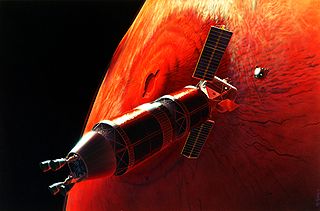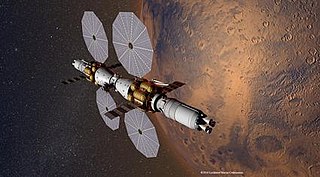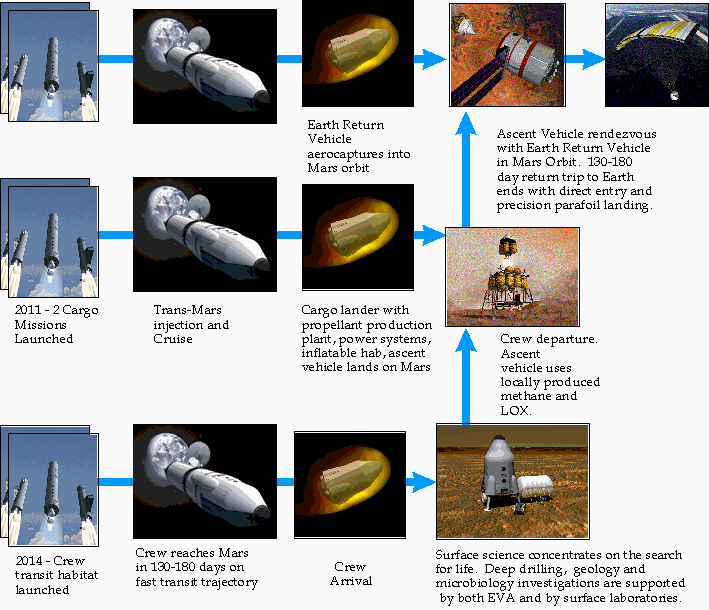
Mars Direct is a proposal for a human mission to Mars which purports to be both cost-effective and possible with current technology. It was originally detailed in a research paper by Martin Marietta engineers Robert Zubrin and David Baker in 1990, and later expanded upon in Zubrin's 1996 book The Case for Mars. It now serves as a staple of Zubrin's speaking engagements and general advocacy as head of the Mars Society, an organization devoted to the colonization of Mars.

Robert Zubrin is an American aerospace engineer, author, and advocate for human exploration of Mars. He and his colleague at Martin Marietta, David Baker, were the driving force behind Mars Direct, a proposal in a 1990 research paper intended to produce significant reductions in the cost and complexity of such a mission. The key idea was to use the Martian atmosphere to produce oxygen, water, and rocket propellant for the surface stay and return journey. A modified version of the plan was subsequently adopted by NASA as their "design reference mission". He questions the delay and cost-to-benefit ratio of first establishing a base or outpost on an asteroid or another Apollo program-like return to the Moon, as neither would be able to provide all of its own oxygen, water, or energy; these resources are producible on Mars, and he expects people would be there thereafter.

The hypothetical colonization of Mars has received interest from public space agencies and private corporations, and has received extensive treatment in science fiction writing, film, and art.

The NASA Institute for Advanced Concepts (NIAC) is a NASA program for development of far reaching, long term advanced concepts by "creating breakthroughs, radically better or entirely new aerospace concepts". The program operated under the name NASA Institute for Advanced Concepts from 1998 until 2007, and was reestablished in 2011 under the name NASA Innovative Advanced Concepts and continues to the present. The NIAC program funds work on revolutionary aeronautics and space concepts that can dramatically impact how NASA develops and conducts its missions.

In orbital mechanics, a free-return trajectory is a trajectory of a spacecraft traveling away from a primary body where gravity due to a secondary body causes the spacecraft to return to the primary body without propulsion.

A Mars Sample-Return (MSR) mission is a proposed spaceflight mission to collect rock and dust samples on Mars and then return them to Earth. Sample-return would be a very powerful type of exploration, because the analysis is freed from the time, budget, and space constraints of spacecraft sensors.

The Ares V was the planned cargo launch component of the cancelled NASA Constellation program, which was to have replaced the Space Shuttle after its retirement in 2011. Ares V was also planned to carry supplies for a human presence on Mars. Ares V and the smaller Ares I were named after Ares, the Greek god of war.
DIRECT was a late-2000s proposed alternative super heavy lift launch vehicle architecture supporting NASA's Vision for Space Exploration that would replace the space agency's planned Ares I and Ares V rockets with a family of Shuttle-Derived Launch Vehicles named "Jupiter".

NASA Design Reference Mission 3.0 was a NASA study for a human space mission to the planet Mars in the 1990s. It was a plan for a human exploration architecture for Mars, and was released in 1998 as an addendum to the early design plans released in 1994. The plan is for a series of multiple launches to send various space transpiration, surface exploration hardware, and human crew to Mars, and to return the crew to Earth in the early 21st century. Various technologies are explored to launch the payloads into space, to send them to Mars, and to reduce overall weight of the mission by various technologies or techniques including nuclear, solar, aerobraking, and in-situ resource use.

A human mission to Mars has been the subject of science fiction since the 1880s, and of aerospace engineering and scientific proposals since the late 1940s. Plans include landing on Mars for exploration at a minimum, with some considering exploring its moons Phobos and Deimos. Longterm proposals have included sending settlers and starting terraforming of the planet.

An orbital propellant depot is a cache of propellant that is placed in orbit around Earth or another body to allow spacecraft or the transfer stage of the spacecraft to be fueled in space. It is one of the types of space resource depots that have been proposed for enabling infrastructure-based space exploration. Many different depot concepts exist depending on the type of fuel to be supplied, location, or type of depot which may also include a propellant tanker that delivers a single load to a spacecraft at a specified orbital location and then departs. In-space fuel depots are not necessarily located near or at a space station.

Space architecture is the theory and practice of designing and building inhabited environments in outer space. This mission statement for space architecture was developed at the World Space Congress in Houston in 2002 by members of the Technical Aerospace Architecture Subcommittee of the American Institute of Aeronautics and Astronautics (AIAA). The architectural approach to spacecraft design addresses the total built environment. It is mainly based on the field of engineering, but also involves diverse disciplines such as physiology, psychology, and sociology. Like architecture on Earth, the attempt is to go beyond the component elements and systems and gain a broad understanding of the issues that affect design success. Space architecture borrows from multiple forms of niche architecture to accomplish the task of ensuring human beings can live and work in space. These include the kinds of design elements one finds in “tiny housing, small living apartments/houses, vehicle design, capsule hotels, and more.”

Mars orbit rendezvous (MOR) is a space travel concept where two spacecraft meet up and/or dock in Mars orbit. For example, one vehicle takes off from Mars, such as a Martian ascent stage, and does a rendezvous in Mars orbit with another spacecraft. Applied to a Mars sample return or human mission to Mars, it allows much less weight to be sent to the surface and back into orbit, because the fuel needed to travel back to Earth is not landed on the planet. It has also been proposed for uncrewed Mars sample return plans.

The SpaceX Red Dragon was a 2011–2017 concept for using an uncrewed modified SpaceX Dragon 2 for low-cost Mars lander missions to be launched using Falcon Heavy rockets.

The Asteroid Redirect Mission (ARM), also known as the Asteroid Retrieval and Utilization (ARU) mission and the Asteroid Initiative, was a space mission proposed by NASA in 2013. The Asteroid Retrieval Robotic Mission (ARRM) spacecraft would rendezvous with a large near-Earth asteroid and use robotic arms with anchoring grippers to retrieve a 4-meter boulder from the asteroid.

Austere Human Missions to Mars is a concept for a human mission to Mars by the United States space agency, NASA. Released in 2009, it proposed a modified and even less costly version of Design Reference Architecture (DRA) 5.0, itself a combination of nearly 20 years of Mars planning design work. The mission profile was for a conjunction class with a long surface stay, pre-deployed cargo, aerocapture and propulsive capture, and some in-situ resource production. As of 2015, the concept had not yet been adapted to the Space Launch System that replaced NASA's Constellation program in 2011.

Crewed Mars rovers are Mars rovers for transporting people on the planet Mars, and have been conceptualized as part of human missions to that planet.

Mars Base Camp (MBC) is a crewed Mars laboratory orbiter concept under study that was commissioned by NASA from Lockheed Martin in US. It would use both future and proven concepts as well as the Orion MPCV, also built by Lockheed Martin.
Compass, is a collaborative engineering team founded in 2006 in support of the LSAM Design Study at NASA's Glenn Research Center in Cleveland, Ohio. The team primarily performs integrated vehicle systems analyses. The team is a logical extension of Glenn's long history of analysis and design of spacecraft. Compass conducts "studies," in which the team receives a request from a contractor to analyze a space system design. The group reviews the parameters of the design, conducts simulations, details the design, and drafts a final report. Working in real time among engineers and scientists with a wide breath of experience allows designs to come together quite rapidly. Compass designs spacecraft with lofty goals in mind; many of their projects seem like they have come out of a sci-fi film. An example of this is a nuclear-powered robot designed to burrow into Europa. Early success of the team allows it to continue to produce preliminary designs of spacecraft. The name "Compass" was originally based on an acronym that has since been deprecated.






















